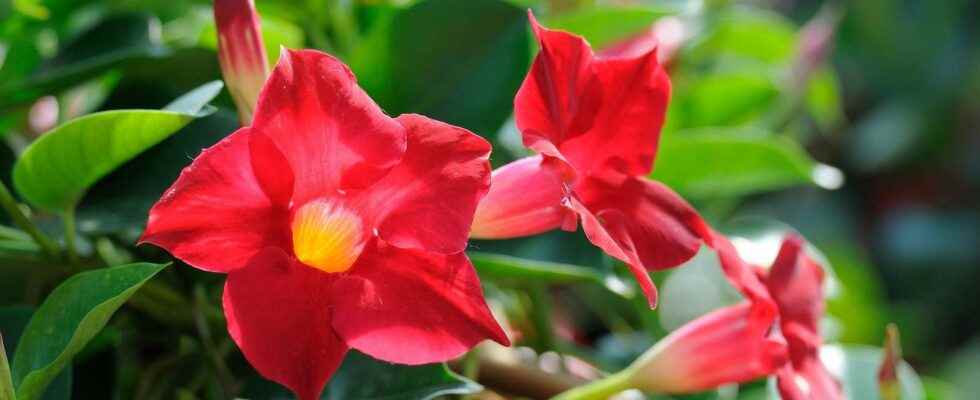This climbing plant is covered with trumpet-shaped flowers all summer long. Its evergreen foliage makes it possible to cover a wall, a trellis or a stake. With flowers of color pink, white or red, you will be seduced by its small air tropical.
Appellations
Dipladenia (Dipladenia) also called Mandevilla, belongs to the Apocynaceae family (Apocynaceae), same family as the oleander. It is also found under the name of “Brazilian jasmine” because it is very present there.
Botanical description of dipladenia
This twining climber is often grown indoors, in a veranda or a gardenwinter because it is not hardy and fears the cold below 0°C. In summer, it acclimatizes perfectly to outdoor climatic conditions. It produces lianas which cling to the supports, are covered with green leaves which can reach several meters but also with very colorful trumpet-shaped flowers, pink, red, white and sometimes red or orange.
Here are some common varieties:
- sanderi ‘Sundaville’: various colors;
- sanderi Diamantina ‘Jade Pink’: pink;
- sanderi Diamantina ‘Jade Scarlet’: scarlet red;
- sanderi Diamantina ‘Jade White’: white;
- sanderi Diamantina ‘Opal Orange Coral’: orange.
Composition with petunias, verbena, grasses and dipladenia. © Molly Shannon, Adobe Stock
Origins of dipladenia
Dipladenia is native to tropical forests from South and Central America.
Dipladenia cultural requirements
The dipladenia likes both in the ground and in a pot, easier to move from May to October. In the south, prefer to install it outside in a massif; in the North, you will return the pot so as not to make it succumb to negative temperatures and cold. Always place it on a semi-shaded position and not in direct contact with the Sun burning. It needs regular watering so that the soil does not dry out completely and can withstand short periods of drought using its tuberous roots which act as a water reserve.
For a subject in a pot, be sure to add regular water because evaporation is greater in a container. As it blooms, remove faded flowers to keep a plant always on top.
Often grown as an annual plant, you can also try to keep it for several years by overwintering it. To do this, put it in a bright, temperate room at 10°C, bringing it a little water until next spring.
From the first days of spring, you can prune the end of the stems to ensure a better start and bring out the potted plants.
Use of Dipladenia
In climbing on a support, the dipladenia can occupy space vertically and vegetate small spaces such as the edges of window or one balcony. In a pot or a planter, its vines can compose a waterfall and bloom a railing from a balcony or low wall. Combine it with decorative foliage of helichrysum, ivy or Pennisetum. In a planter, it will easily accompany ivy geraniums to flower the edge of a window. In pretty pots and guided on stakes, install a dipladenia on each side of your gate entrance to welcome your guests.
You will also be interested
[EN VIDÉO] Garden: 5 flowers that tolerate drought well All plants need water to live. But some tolerate long periods of drought well. With these 5 flowers, the chore of watering is over!
Interested in what you just read?
